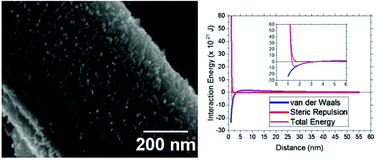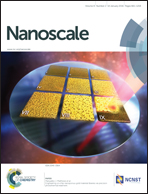Heteroaggregation assisted wet synthesis of core–shell silver–silica–cadmium selenide nanowires†
Abstract
A method has been developed for the wet solution synthesis of core shell heterogeneous nanowires. An ultrathin silica layer was first grown around plain silver nanowires to act as a suitable insulator. An outer nanoparticle layer was then attached through heteroaggregation by dispersing the un-functionalized nanowires in toluene solutions containing nanoparticles of CdSe or Au. Total coverage of nanoparticles on nanowires was found to increase with the nanoparticle size, which is attributed to the increase in the van der Waals interaction between the nanoparticles and the nanowire with the increasing size of nanoparticles. Using this method, we achieved over 79.5% coverage of CdSe nanoparticles (24 nm × 11 nm) on the nanowire surface. Although following the same trend, Au nanoparticles show an overall lower coverage than CdSe, with only 24.2% coverage at their largest particle size of 19 nm in diameter. This result is attributed to the increase in steric repulsion during attachment due to the increasing length of capping ligands. Investigation of the core–shell nanowire's optical properties yielded CdSe Raman peak enhancement by a factor of 2–3 due to the excitation of surface plasmon propagation. Our method can be applied to the attachment of a wide range of nanoparticles to nanowire materials in non-polar solution and the core–shell nanowires show great potential for incorporation into various microscopic and drug delivery applications.


 Please wait while we load your content...
Please wait while we load your content...